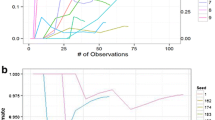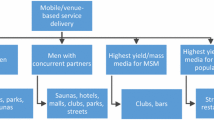Abstract
This paper evaluates the effectiveness of respondent driven sampling (RDS) to sample males who have sex with males (MSM) in Dhaka, Bangladesh. A major objective for conducting this survey was to determine whether RDS can be a viable sampling method for future routine serologic and behavioral surveillance of MSM as well as other socially networked, hard to reach populations in Bangladesh. We assessed the feasibility of RDS (survey duration; MSM social network properties; number and types of initial recruits) to recruit a diverse group of MSM, the efficacy of an innovative technique (systematic coupon reduction) to manage the implementation and completion of the RDS recruitment process and reasons why MSM participated or did not participate. The findings provide useful information for improving RDS field techniques and demonstrate that RDS is an effective sampling method for recruiting diverse groups of MSM to participate in HIV related serologic and behavioral surveys in Dhaka.



Similar content being viewed by others
References
Abdul-Quader, A., Heckathorn, D., McKnight, C., Bramson, H., Nemeth, C., Sabin, K., Gallesher, K., & Des Jarlais, D. (2006). Effectiveness of respondent driven sampling for recruiting drug users in New York City: Findings from a pilot study. Journal of Urban Health, 83(3), 459–476.
Dowset, G., Grierson, J., & McNally, S. (2006). A review of knowledge of sexual networks of behaviors of men who have sex with men in Asia: Annotated bibliography. Australian Research Centre in Sex, Health and Society. La Trobe University, Melbourne, Australia. Monograph series number 59.
Erickson, B. H. (1979). Some problems of inference from chain data. Sociological Methodology, 10, 276–302.
Family Health International. (2000). Behavioral surveillance surveys: Guidelines for repeated behavioral surveys in populations at risk of HIV. FHI, Arlington, VA. http://www.fhi.org/en/HIVAIDS/pub/guide/bssguidelines.htm
Goel, S., & Salganik, M. (2007). Respondent driven sampling as Markov Chain Monte Carlo. University of California, Los Angeles. http://www.rcf.usc.edu/∼sharadg/papers/RDSasMCMC.pdf
Government of Bangladesh. (2003). National HIV serological surveillance, 2002, Bangladesh: Fourth round technical report. National AIDS/STD programme, directorate general of health services, Ministry of Health and Family Welfare, Dhaka. http://www.icddrb.org/activity/index.jsp?activityObjectID=2430
Government of Bangladesh. (2005). National HIV serological surveillance, 2004–2005, Bangladesh: Sixth round technical report. National AIDS/STD programme, directorate general of health services, Ministry of Health and Family Welfare, Dhaka. http://www.icddrb.org/activity/index.jsp?activityObjectID=2080
Heckathorn, D. (1997). Respondent driven sampling: A new approach to the study of hidden populations. Social Problems, 44(2), 174–199.
Heckathorn, D. (2002). Respondent driven sampling II: Deriving valid population estimates from chain-referral samples of hidden populations. Social Problems, 49(1), 11–34.
Johnston, L. G., Huong, P. T., Hien, M. T., Chau, L. M., & Hau, D. H. (2005). HIV prevalence and risk factors among injecting drug users in Ho Chi Minh City, Vietnam. Presented at the international conference for the reduction of harm among injecting drug users. Belfast, Ireland.
Johnston, L. G., Sabin, K., Hien, M. T., & Huong, P. T. (2006). Assessment of Respondent driven sampling for recruiting female sex workers in two Vietnamese cities: Reaching the unseen sex worker. Journal of Urban Health, 83(Suppl. 7), 16–28.
Johnston, L. G. (2007). Conducting respondent driven sampling studies in diverse settings: A manual for planning RDS studies. Arlington, VA: Centers for Disease Control and Prevention, Atlanta, GA and Family Health International.
Klovdahl, A. (1989). Urban social networks: Some methodological problems and possibilities. In M. Kocken (Ed.), The small world. Norwood, NJ.
Khan, S., Khan, S. I., & Hollerbach, P. E. (2005a). In their own words: The formulation of sexual and health related behavior among young men in Bangladesh, summary report. Washington, DC: Catalyst Consortium.
Khan, S. I., Hudson-Rodd, N., Saggers, S., & Byutya, A. (2005b). Men who have sex with men’s sexual relations with women in Bangladesh. Culture, Health and Sexuality, 7(2),159–169.
Magnani, R., Sabin, K., Saidel, T., & Heckathorn, D. (2005). Sampling hard to reach and hidden populations for HIV surveillance. AIDS, 19(Suppl. 2), S67–S72.
McPherson, M., Smith-Lovin, L., & Cook, J. M. (2001). Birds of a feather: Homophily in social networks. Annual Review of Sociology, 27, 415–444.
Ogunnaike-Cooke, S., & Bombereau, G. (2007). Report of the pilot behavioural and HIV seroprevalence surveillance surveys of men who have sex with men and female sex workers in Antigua and Barbuda and St. Vincent and the Grenadines. Caribbean Epidemiology Centre-Special Programme on Sexually Transmitted Infections. Port of Prince, Trinidad.
Platt, L., Wall, M., Rhodes, T., Judd, A., Hickman, M., Johnston, L. G., Sarang, A., & Bobrova, N. (2006). Methods to recruit hard-to-reach groups: Comparing two chain referral sampling methods of recruiting injecting drug users (IDU) across nine studies in Russia and Estonia. Journal of Urban Health, 83(Suppl. 7), 28–34.
Ramirez-Valles, J., Heckathorn, D., Vasquez, R., Diaz, R. M., & Campbell, R. (2005). Respondent driven sampling among gay men: Lessons from a two-city field study with Latino gay men. AIDS and Behavior. doi:10.1007/s10461-005-9012-3.
Salganik, M. (2006). Variance estimation, design effects, and sample size calculations for respondent-driven sampling. Journal of Urban Health, 83(Suppl. 7), 98–112.
Salganik, M., & Heckathorn, D. (2004). Sampling and estimation in hidden populations using respondent-driven sampling. Sociological Methodology, 34, 193–239.
Semaan, S., Lauby, J., & Liebman, J. (2002). Street and network sampling in evaluation studies of HIV risk-reduction interventions. AIDS Review, 4, 213–223.
Simic, M., Johnston, L. G., Platt, L., Baros, S., Andjelkovic, V., Novotny, T., & Rhodes, T. (2006). Exploring barriers to ‘Respondent Driven Sampling’ in sex worker and drug-injecting sex worker populations in Eastern Europe. Journal of Urban Health, 83(Suppl. 7), 6–15.
Stromer, A., Tun, W., Guili, L., Harxhi, A., Bodanovskaia, Z., Yakovleva, A., Rusakova, M., Levina, O., Bani, R., Rjepaj, K., & Bino, S. (2006). An analysis of respondent driven sampling with injection drug users in Albania and the Russian Federation. Journal of Urban Health, 83(Suppl. 7), 73–82.
UNAIDS/WHO (2000). Guidelines for second generation HIV surveillance for HIV: The next decade. UNAIDS/WHO: Working group on global HIV/AIDS and STI Surveillance. http://www.who.int/hiv/pub/surveillance/pub3/en/index.html
Yeka, W., Maibani-Michie, G., Prybylski, D., & Colby, D. (2006). Application of respondent driven sampling to collect baseline data on FSWs and MSM for HIV risk reduction intervention in two urban centers in Papua New Guinea. Journal of Urban Health, 83(Suppl. 7), 1–5.
Acknowledgments
The survey was conducted by ICDDR,B in collaboration with IEDCR, on behalf of the Govt. of Bangladesh, with support of grant from Govt. of Bangladesh/DFID/IDA, credit number 3441 BD. Family Health International, Dhaka provided technical assistance. The ICDDR,B acknowledges with gratitude the commitment of the different development partners to the Centre’s research efforts. We also acknowledge with gratitude all participants and staff of the survey.
Author information
Authors and Affiliations
Corresponding author
Rights and permissions
About this article
Cite this article
Johnston, L.G., Khanam, R., Reza, M. et al. The Effectiveness of Respondent Driven Sampling for Recruiting Males Who have Sex with Males in Dhaka, Bangladesh. AIDS Behav 12, 294–304 (2008). https://doi.org/10.1007/s10461-007-9300-1
Received:
Accepted:
Published:
Issue Date:
DOI: https://doi.org/10.1007/s10461-007-9300-1




